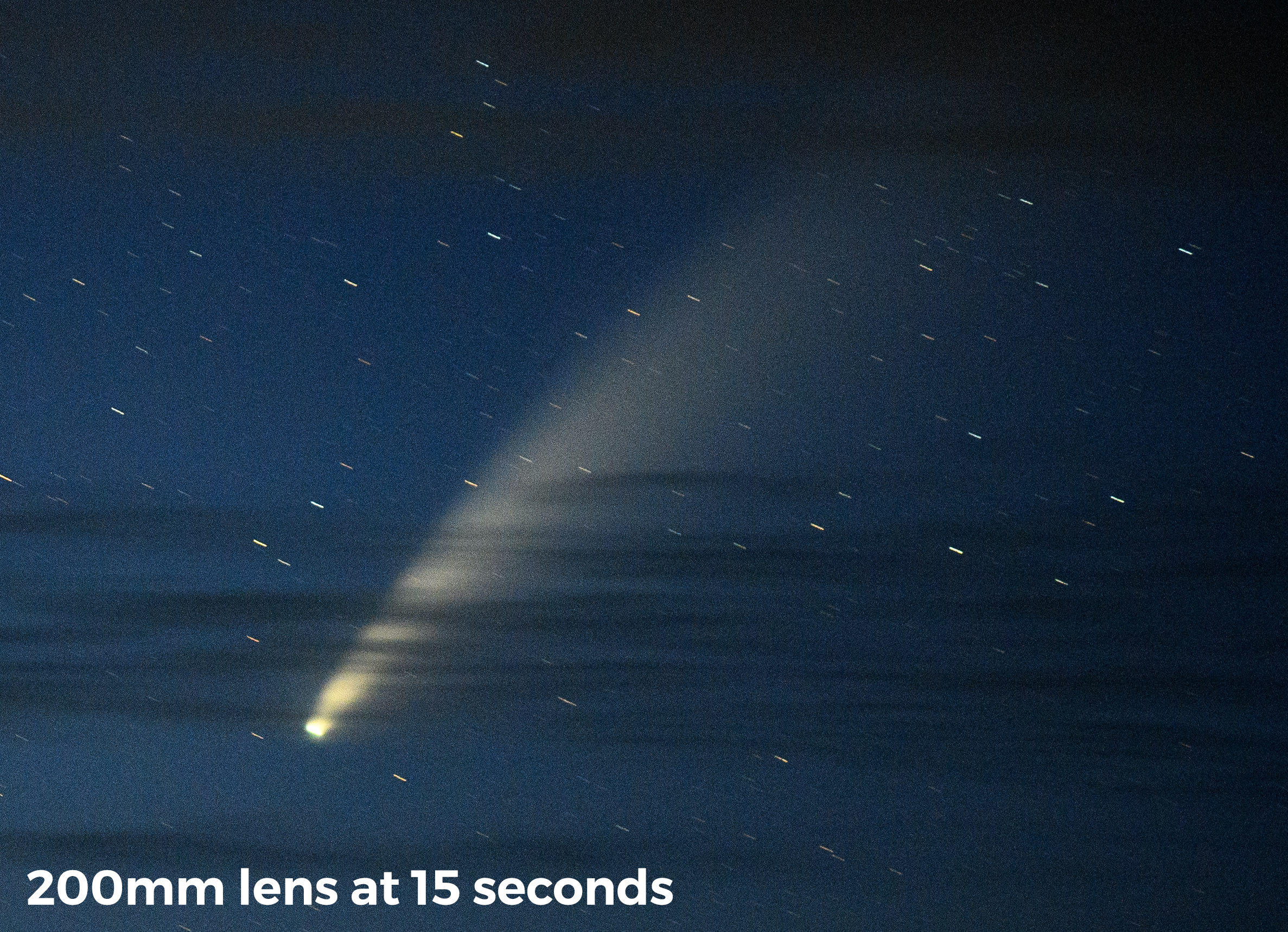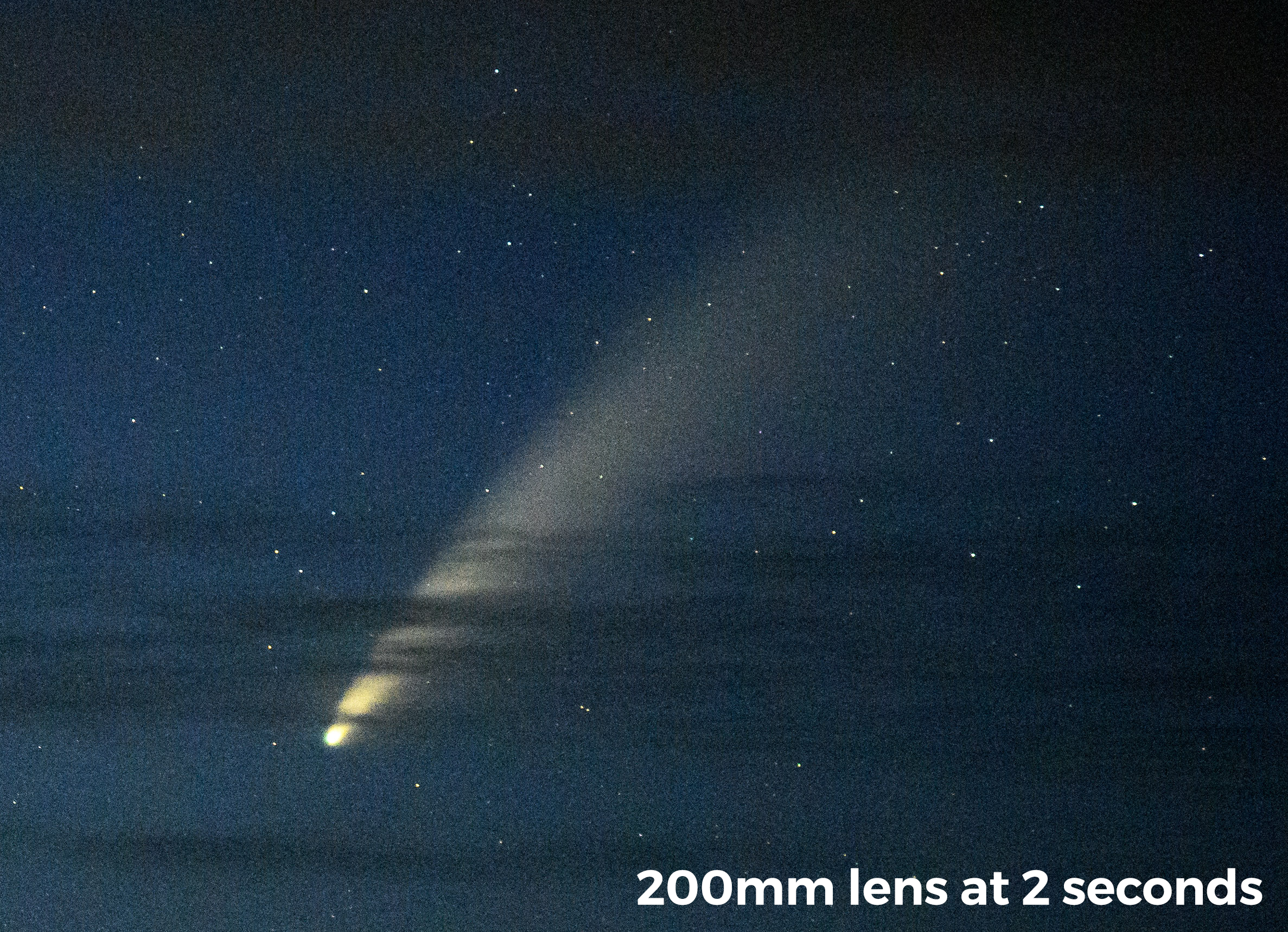Night photography isn’t just our livelihood—it’s also our passion, and our art. As much as we love to teach, we also love to venture into the field and shoot, especially when something special is happening in the sky. Comet NEOWISE certainly met the standard of “something special.”
So a couple of weeks ago, when the comet began appearing among the stars, we knew we wanted to get out to make some photos of it. Lance and I were heading to coastal Maine to run back-to-back moonless workshops. Matt was at home in the beautiful Catskill Mountains of New York. All three of us were in perfect places at perfect times.
NEOWISE is now fading from view, but won’t be fading from memories. Below you’ll find some of the images we created.
Lance
A single exposure of Comet NEOWISE and the Monhegan Lighthouse made by covering and uncovering the lens for 3-second intervals. The slowly rotating light has six beams and makes a full rotation once every minute and a half. I first worked on this technique last year during our Cape Cod workshop while photographing Nauset Light in Eastham, Massachusetts. Nauset Light’s beam rotates much faster, and required covering and uncovering the lens a couple of times per second. Chris figured out that 3-second intervals worked well for this one, and I got lucky with this shot by using his timing. · Nikon D750 with a Tamron 15-30mm f/2.8 lens at 20mm. 25 seconds, f/3.2, ISO 6400.
A dory and the back of the keeper’s house at Monhegan Lighthouse, with Comet NEOWISE between the roof peaks. This is a composite of two exposures––one for the sky and a second longer exposure for the foreground. A smaller aperture was needed for depth of field, which necessitated the higher ISO for the sky shot and a longer exposure for the foreground. This type of subject matter is exactly the kind of thing that I love to shoot, and I would have made the same composition even without the comet. Bonus! · Nikon D750 with a Nikon 24-120mm f/4 lens at 44mm. Sky shot at 10 seconds, f/4.5, ISO 12,800; foreground shot at 70 seconds, f/4.5, ISO 6400.
Jordan Pond and the famous Bubbles of Acadia National Park, with the comet in the northwestern sky. A composite of different exposures for the foreground and sky. I generally like to get everything in one frame, but the short shutter speeds required to keep the stars and comet sharp combined with the need to stop down for depth of field made this image virtually impossible without compositing. I partially desaturated and added a fair amount of contrast, both to make the image bolder and to minimize any noise issues from the high ISOs. · Nikon D750 with a Tamron 15-30mm f/2.8 lens at 17mm. Sky shot at 25 seconds, f/4, ISO 6400; foreground shot at 270 seconds, f/4, ISO 6400.
Matt
It’s been really cloudy here in the Catskills, and when I finally had a clear night, it was cloudy at the horizon. So I really did not get a crack at NEOWISE until the night of the new moon on July 20. I started with my 15mm lens and shot single images. At first I was surprised and a little unhappy about the light pollution—but then I reminded myself that with the new moon everything would have been dark, and the light pollution illuminated the valley below and gave context to the image. · Nikon Z 6 with a Venus Optics Laowa 15mm f/2 FE Zero-D lens. 15 seconds, f/2.8, ISO 6400.
When I saw the massive galactic core behind me over the mountain, I wanted to shoot for a Milky Way arch with the comet. With 13 images and a really aggressive tilt upward, I was totally surprised the stitch worked. I usually shoot dead level. And I think the S-curve of the mountain to the valley along the bottom works well. I also love the comet arcing in the same curve as the Milky Way. All in all, I was happy with the one night of shooting. Alas, it’s been cloudy ever since! · Nikon Z 6 with a Venus Optics Laowa 15mm f/2 FE Zero-D lens. 13 stitched frames shot at 20 seconds, f/2.8, ISO 6400.
Chris
This was my first real chance to focus on photographing the comet. I’d seen it a few times in the nights prior, but had been focused on helping workshop participants so didn’t shoot anything more than a snapshot. But on this night it was just Lance and I out working together at the Monhegan Island Lighthouse in Maine. The evening started off foggy, and the comet wasn’t even on our radar. But suddenly the northern and western skies cleared (that kind of thing can happen in New England), and there it was! I framed the comet between the fog bell and the keeper’s quarters; I light painted the former, and the lighthouse painted the latter. · Nikon D5 with a Nikon 14-24mm f/2.8 lens, light painted with a Luxli Viola. 25 seconds, f/3.5, ISO 6400.
I’d spotted this scene earlier in the evening, and came back to it as my last stop of the night—once the comet had set low enough. I saw it as a black and white image from conception, partly because the color temperatures were different on the horizon and in the window, and partly because it just felt like an old-time black and white scene. What I didn’t realize, even in the dark, was that the long exposure would reveal in the window someone’s head on the pillow. Why were they sleeping through the comet? · Nikon D5 with a Nikon 24-70mm f/2.8 lens. 16 frames shot at 5 seconds, f/2.8, ISO 25,600, stacked in Sequator.
For a week I knew I wanted to photograph the comet over Jordan Pond in Acadia National Park—one of my happy places. When we got there, the night was perfectly clear, and I got my chance for this pano. · Nikon D5 with a Nikon 24-70mm f/2.8 lens. Six stitched frames shot at 15 seconds, f/2.8, ISO 6400.
My favorite images I’ve seen of the comet are those that incorporate it into a landscape or a wider scene, so that’s mostly what I tried to work on. But I wanted to make just one portrait of NEOWISE. I did so from the northwest shores of Monhegan Island. I liked the blend of colors from the horizon into the deeper blue of the night sky, as well as the deep blues of the Atlantic below—so that became my backdrop for NEOWISE. · Nikon D5 with a Nikon 24-70mm f/2.8 lens. 32 frames shot at 5 seconds, f/2.8, ISO 25600, stacked in Sequator.
Wrapping Up
Now that we’ve shown you our images, we’d love to see yours! Please share your comet photos and stories in the comments or on our Facebook page, or post them on Instagram and tag @nationalparksatnight. Or all three!












